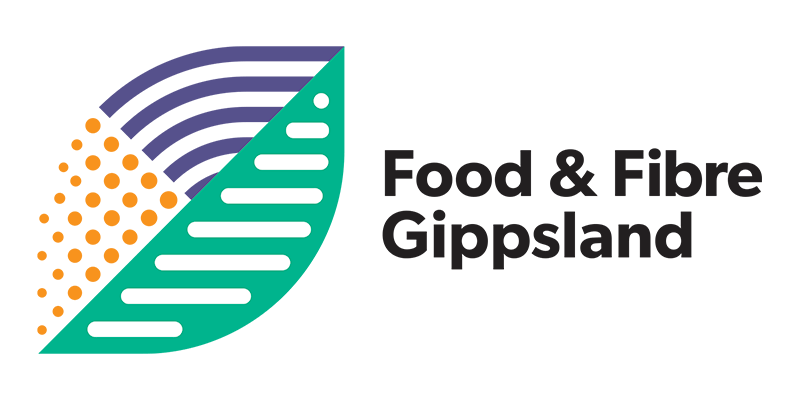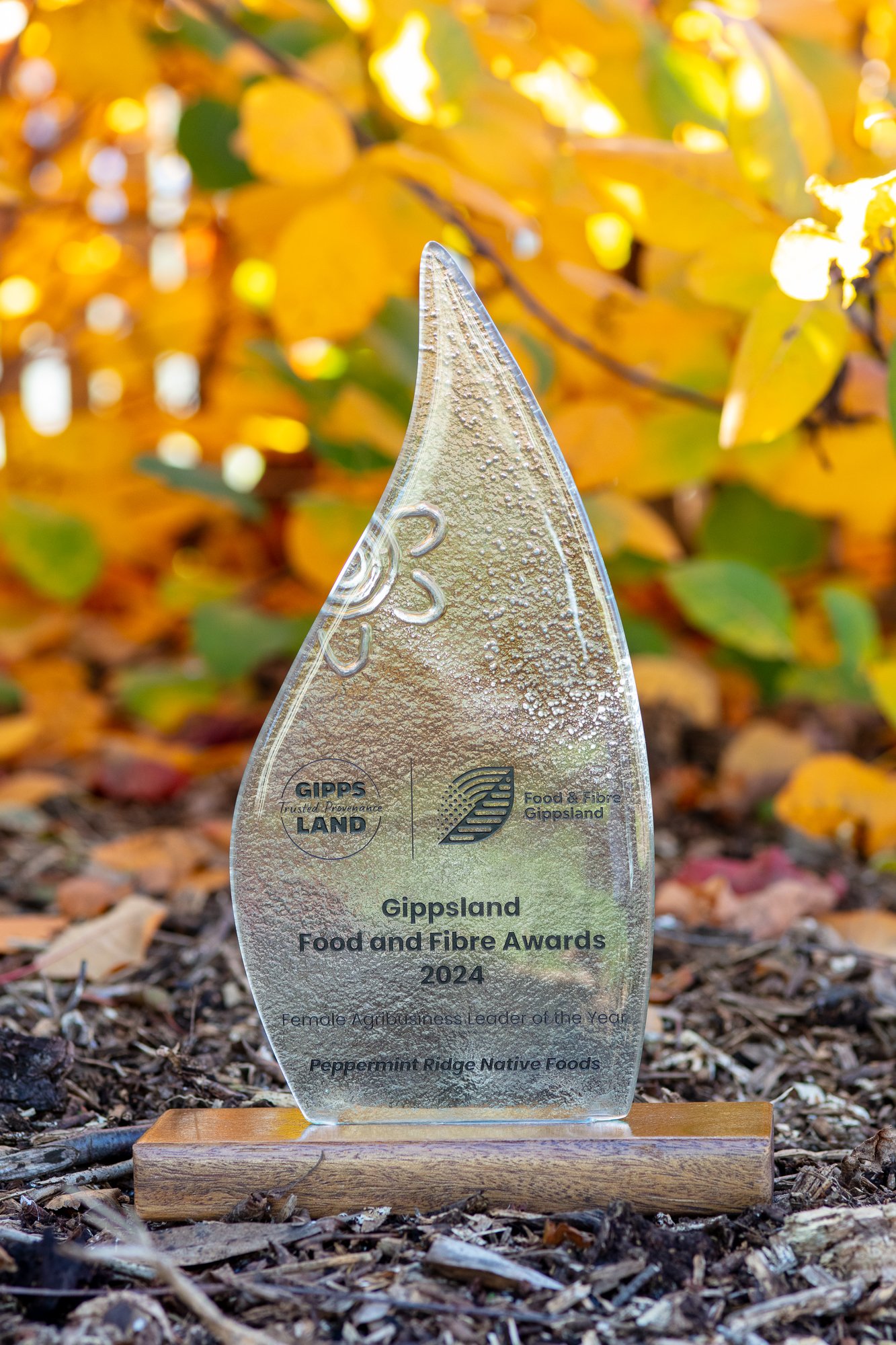Peppermint Ridge Farm: specialising in native food propagation, growing and harvesting
Expanding on our series of articles that recognise leading agribusinesses in our region, we profile native food producers Peppermint Ridge Farm. Owner and director Julie Weatherhead was bestowed the premier acknowledgement of Female Agribusiness Leader of the Year at the 2024 Gippsland Food and Fibre Awards.
Peppermint Ridge Farm is located at Tynong North on an eight hectare property adjoining the Bunyip State Park.
Specialising in native food propagation, growing and harvesting, the farm is a living example of bush foods and native botanicals grown in harmony with the natural environment.
Owners Julie Weatherhead and Anthony Hooper have created a unique business model that integrates horticulture, specialist nursery, eco-tourism, education, value-added products and hospitality.
Growing and selling fresh seasonal native fruits and berries, as well as native teas, spices and dukkah to restaurants and cafés is one element of an operation that regularly sends produce interstate.
“The whole supply chain is integral to what we do,” Julie said.
Importantly, Julie and Anthony are also seeking to reframe public perception about Australia’s native foods.
“What you see is a gum tree,” Anthony said, pointing to a strawberry gum in the established native food display garden. “But the message we share is that it’s all food; the leaves provide a crop of aromatic spice.”
As educators, they passionately impart their combined knowledge of sustainable land management by welcoming visitors to the farm and offering a broad selection of Taste, Learn, See experiences.
Perhaps aptly, the learning takes place in dual environments: both outside on the farm, and in a lovingly relocated and restored schoolhouse that was once the Nar Nar Goon North State School, circa 1929.
The schoolhouse operates as a café, running regular monthly bushfood tour and taste lunches, in addition to native pantry cooking classes for apprentice chefs and interested members of the public.
Doubling as a function centre, Julie and Anthony’s ‘living classroom’ is the site of informative educational experiences for groups, schools and universities, where knowledge of the use of native ingredients is passed on.
Julie’s significant agricultural background and commitment to education impressed the judges in the 2024 Gippsland Food and Fibre Awards, an acknowledgement that earned her recognition as Female Agribusiness Leader of the Year.
With the ever-expanding interest in bush foods favoured by chefs, foodies and providores nationally, Peppermint Ridge Farm has seen their range of value-added products in strong demand.
When Food & Fibre Gippsland visited in December last year, a fragrant aroma of botanicals was evident as we entered the property. It was a warm day, and the native plants offered a vibrant olfactory experience.
Enthusiastically, Julie and Anthony took us on a tour of the mature display garden, providing an opportunity to be immersed in our own see, taste and smell experience.
Ripening apple berries (Billardiera mutabilis) were first; Julie likens the flavours of the fully ripe fruit as similar to apple and kiwi fruit.
Finger limes (Citrus australasica) followed, with fat fingers of fruit growing prolifically on a small, thorny understorey plant. Also known as a caviar lime, its edible contents are full of tiny ‘pearls’ containing tangy, citrus-flavoured juices.
“We use the bush foods from our farm in the cooking school, with apprentice chefs from all the campuses of TAFE Gippsland,” Julie said.
“I also provide training in the many uses of bushfoods to emerging young chefs, including the Proud to be a Chef program sponsored by Fonterra. It’s a culinary experience that familiarises them with native ingredients.”
Our garden tour continues with a sample of river mint (Mentha australis), a highly aromatic genuine mint from the Mentha genus.
“The dried leaves can be used to make tea, or added as an ingredient for cooking,” Julie said.
“I’ve honestly made the best panna cotta in my life with native river mint.”
Midyims (Austromyrtus dulcis) are next. The glorious-looking white fruit are covered in purple spots, closely resembling birds’ eggs. Midyim berries are tangy yet sweet. A small edging shrub, the evergreen foliage lends itself to being grown as an edible hedge.
Julie offers us a sprig of cinnamon myrtle (Backhousia myrtifolia). It’s a plant that has broad application for its leaves when used in sweet or savoury dishes, or steeped in hot water and consumed as a tea. We crush the leaves in our hands to release a warm and spicy aroma.
Like most of the species grown at Peppermint Ridge Farm, flowers from the cinnamon myrtle provide vital food for bees and other pollinators. This cross-pollination process plays an important role in the sustainability of the farm’s botanical lifecycle.
We’re introduced to the Davidson plum (Davidsonia jerseyiana), a subtropical plant that thrives on Anthony and Julie’s farm. When we visited, flowers were forming on the stems prior to transforming into brilliantly-coloured clusters of fruit as summer advances.
At this point, Anthony explains that it’s the oils extracted with heat which derive the most intense flavour from bush foods, while essences sourced from cold extraction will produce a more subtle result.
Our guided tour continues with an introduction to old man salt bush (Atriplex nummularia), a plant that was once widely found across arid parts of Australia but has been depleted by overgrazing. The leaves are used by Julie to make saltbush chips as well as a spice mix with mountain pepper and lemon myrtle..
In producing their crops, Anthony and Julie are respectful of the Kulin Nation, the Traditional Custodians of the land, their connection to Country, and cultural knowledge of bush foods and traditional medicine gathered over tens of thousands of years.
Small-leaved tamarind (Diploglottis campbellii) was also flowering on our visit, its fruits just starting to form. Imparting a deliciously sour and potent flavour, they retain their strong orange colour.
“It’s actually a lychee,” Julie said.
“And although it’s a sub-tropical plant, it loves the Gippsland climate. Frosts or hot weather don’t seem to bother it at all.”
Julie makes salad dressings with the harvest, and her ever-popular tamarind jam; the tangy flavours lending themselves well to chutneys, or even sorbet.
With fruit flavoured “like Jaffas”, Julie tells us, there were once vast forests of small-leaved tamarind, but now overclearing has seen its presence reduced.
In recent years, Anthony and Julie have been working with the University of Melbourne to undertake exploratory testing of their plants, including lemon myrtle, anise myrtle, mountain pepper and small-leaved tamarind.
“Researchers have discovered that the small-leaved tamarind is full of the biggest range of antioxidants of any fruit they have previously studied,” Anthony said.
“All the plants tested have huge potential as health foods and compared to the blueberry, they contain more antioxidants, vitamins and minerals.”
As we come to the end of our edible garden tour, we view the stunning mountain pepperberry (Tasmannia lanceolata), a plant featured on the cover of Julie’s self-published and award-winning book Australian Native Food Harvest: A Guide for the Passionate Cook and Gardener.
Anthony tells us the pepperberry is highly suitable to being grown as a commercial crop within parts of the Gippsland region, for horticulturalists or agribusinesses equipped with cultivation knowledge.
“Both male and female plants are required for cross-pollination,” Anthony said.
“As an understorey species, pepperberries can be grown as a windbreak and make an excellent value-added crop. We currently grow between 200 – 400 plants.”
Julie added, “I was cooking with the young chefs yesterday. We made pesto with lemon myrtle leaf and pepperberries, and the warrigal greens which are a type of native spinach.”
Harvesting the mountain pepperberries requires a gentle and selective approach.
Amongst all the glossy berries, Julie says, are next year’s flowers.
“Much care needs to be taken to harvest only the fruits, and leave the flowers intact,” Julie said.
“They’re the beginning of next year’s crop.”
Julie explains that the pepperberry requires few inputs to thrive; only blood and bone, plus water and mulch are all that’s necessary for a productive planting. However, it must be planted in a sheltered position and needs summer watering.
“In terms of pests, it’s our experience that nothing really bothers this species.”
What’s incredible about the pepperberry is that it grows through winter, thriving in the colder regions of Gippsland and making it a highly suitable crop for a temperate environment.
Favouring permaculture methods, Peppermint Ridge Farm uses a system of horticulture that grows species as a polyculture; packed tightly together, the smaller trees and shrubs thrive, protected by the canopy of larger species. Lemon myrtle (Backhousia citriodora), favoured for its culinary uses, is among the plants that flourish in this environment.
Bush tea tastings are a feature of the Tour and Taste experiences, introducing foodies to sensory experiences that include anise myrtle, with a distinct liquorice flavour; and the delightfully refreshing river mint, among others.
On the day of our visit, we were fortunate to experience Julie’s freshly-baked strawberry gum, chocolate and zucchini muffins, served with finger lime and strawberry gum sugar cream on the side; the finger lime provided a zesty lighter note alongside the rustic muffin flavours.
For those who are keen to try their hand at growing bush foods, Peppermint Ridge Farm’s native nursery stocks a wide selection of plants, such as lemon myrtle, anise myrtle and mountain pepper. At least thirty species can be experienced in the farm’s display garden and seedlings can be sent by mail order to most Australian states (biosecurity laws permitting).
An ongoing calendar of lunches and culinary classes provide unique taste, learn, see experiences onsite, while a selection of shelf-stable products – such as bush teas and native spices – can be purchased from the online pantry.
Photo credits:
Midyim berries: Getty Images
GTP logo, image of Julie’s book, glass trophy photo and Gippsland Food and Fibre Awards image: Food & Fibre Gippsland
All other images: Peppermint Ridge Farm; copyright used with permission from Australian Native Food Harvest.
Photos, top to bottom:
finger lime
lemon myrtle (L) and small-leaved tamarind (R)
the schoolhouse café with Bunyip State Park in the background (L); Julie Weatherhead taking a sourdough cookery class (R)
the native food display garden at Peppermint Ridge Farm
native thyme
new growth, Davidson plum
Midyim berries (L); trophy awarded to Peppermint Ridge Farm, Gippsland Food and Fibre Awards 2024 (centre); Juile Weatherhead receiving her award as Female Agribusiness Leader of the Year, May 2024 (R)
Julie educating schoolchildren with native plantings (L); Julie Weatherhead (centre); Anthony Hooper (R).
Peppermint Ridge Native Foods is a Food & Fibre Gippsland member.
















